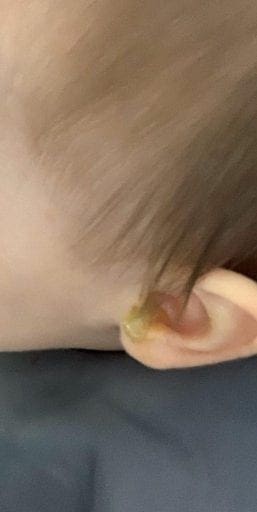
Purulent otitis media
Naturally, purulent otitis media is less common and is considered part of those cases of acute otitis media.
But even here the management and care are unique and therefore worth getting to know.
What is purulent otitis media and how does it occur?
Purulent otitis media is an infection of the middle ear in which the eardrum is torn and pus is spilled into the ear canal and the eardrum area (see photo below).
Basically what happens is that pus accumulates in the middle ear up until the pressure there causes perforation in the eardrum.
I see two types of children with purulent otitis media:
Those in which it was impossible to do anything else – without any preliminary symptoms, neither restlessness and certainly not fever, the child gets up in the morning and there is a puddle of pus near his ear.
Those in which early diagnosis might have prevented the perforation – children who walk around with acute otitis media, do not go to the doctor or who arrive and are not properly diagnosed. The pressure in the middle ear increases until the eardrum punctures. In such children, who usually present with bulging of the eardrum before it is perforated, there was room for immediate antibiotic treatment that might have prevented the perforation (not always).
Clinically it is important to emphasize, even if the child had symptoms suitable for acute otitis media, for example fever and earaches, usually after the perforation has occurred, the child will feel better. In fact, the release of pus, relieves the pressure from the ear and usually the pain and fever disappear.
What is the right treatment in case of purulent otitis media?
If the child came to the doctor after the puncture had already occurred and the child did not receive any antibiotics before, then usually the doctor will refrain from giving oral antibiotics. Since the child has already greatly improved it is not needed anymore.
The doctor must look at the other ear, where there was no perforation, in order to see that there is no inflammation in this ear also.
It is important to recommend local treatment to dilute the pus – hydrogen peroxide at a concentration of 3% three times a day. When the hydrogen peroxide is dripped on the pus in the canal, fermentation will take place, which is actually the disintegration of the pus that will spill out. That’s the goal. After disintegration of the pus, the canal opening area can be dried and cleaned.
Sometimes the doctor will recommend local ear drops.This is really not necessary except in cases of auditory canal irritation due to pus.
Oral antibiotic treatment will only be given if the child still has symptoms such as fever or earache or in cases where the discharge continues for more than two weeks.
Can purulent otitis media be contagious?
A purulent otitis media is a non-contagious infection, although I would not want the pus that slides out of a child’s ear to reach others. Therefore, the child can return to regular activity in the educational institution where he is, about 24 hours after the fever breaks, when he feels well and when the amount of secretion from the ear is significantly reduced.
Can purulent otitis media cause hearing loss and does it require expert advice from a pediatric ENT specialist?
Purulent otitis media is just an extreme end of acute otitis media. Even if there is a rupture of the eardrum several times it will usually not cause hearing damage.
Do not get it wrong, if you as a doctor see the child a moment before the perforation – give him antibiotics and try to prevent the perforation. But if it has already happened there is usually no need for further treatment.
However, purulent otitis media that recur frequently, for example 3 times in six months or 4 times a year, require an evaluation by a pediatric ENT specialist in children and consideration of ventilation tubes surgery.
Managing a chronic discharge from the ear (not one that happens here and there for few days) is more complex and requires a combination of a pediatrician and a pediatric ENT specialist.
In summary:
It is not a pleasent thing to have your child going around with pus draining from his ear. But understanding what is the right management will help you make it more easy.
For comments and questions, please register
